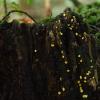
21-05-2016 09:45
Elisabeth StöckliBonjour,Trouvé au sol sur branches cortiquées de

23-05-2016 17:07
Lepista ZacariasHi everyone,If I understood correctly the explanat

23-05-2016 13:03
Dragiša SavicHello everyone,I found this Niesslia species on de

23-05-2016 11:30
 Jacques Fournier
Jacques Fournier
Hello forum,This ascomycete intrigues me. I found

22-05-2016 20:56
Hi to everybody This fungus was collected on smal

22-05-2016 20:25
 Illescas Tomás
Illescas Tomás
Buenas tardes a todos:En la misma hoja de Quercus

22-05-2016 19:09
En hoja de Castaño, junto con Coccomyces delt

22-05-2016 10:34
 Bernard CLESSE
Bernard CLESSE
Bonjour à tous,Voici un asco qui me fait penser �

22-05-2016 14:24
 Illescas Tomás
Illescas Tomás
Hola a todos:Adjunto imágenes de una recolecta de
 Hi -
Hi - I recently sequenced one of my collections from a cloud forest in Veracruz, Mexico. I haven't done any microscopy yet, but I can.
I was surprised to see that there were no close matches. Can anyone turn this ITS sequence into useful information?
Or will I have to do the micro work to figure out what this is?
I could also do LSU sequences....
The ITS sequence is:
CCGCCGTACGTGCCGGGCGTACGCGTCCGGTATCTACGGCGGGGGGCTGTAGAGATAACCACACCCGTGT
ATAGCCTACTCTTGTTGCTTTGGCAGGCCGTGGTCTCCACTGTGGGCTTTGCTCACACGTGCCCGCCAGA
GGATTTAATTCTGAATATTGGTGTCGTCTGAGTACTATATAATAGTTAAAACTTTCAACAACGGATCTCT
TGGTTCTGGCATCGATGAAGAACGCAGCGAAATGCGATAAGTAATGTGAATTGCAGAATTCAGTGAATCA
TCGAATCTTTGAACGCACATTGCGCCCGGTGGTATTCTGCCGGGCATGCCTGTTCGAGCGTCATTGTGAC
CAATCAAGCTCGGCTTGGTGTTGGGTCCGCGGAATCGCGGTCCTCAAATCTGGTGGCGGTGCCATTGGGC
TCTAAGCGTAGTAAATGCTCTCCCGCTATAGAGTTCCTCTGGTAGCTTGCCAGAACCCCCCACTTTCTAC
GGTTGACCTCGGATCAGGTAGGGATACCCGCTGAACTTAAGCATATCAATAAGCGGAGGAA

here is a phylo-tree genarated by the Blastn of your sequence, which suggests that the closest genus to your fungus could be Phialocephala.
Regards,
Christian

Bonjour Alan,
The genus name proposed by Christian sounds fully exotic to me . I would appreciate closer macro pictures and of course also micros . According to Syllabus of Plant Families, it belongs in the Mollisiaceae families ...
Amitiés
Michel

If you have the fungus fresh, please do it in water, also if it was dried no longer than a few months ago. The spores could still be alive and then give more information.
In my Mollisia tree it falls with great distance near Barrenia and Phialocephala urceolata/Mollisia olivascens, but that could be an accident.
Zotto

 Phylo-tree-ITS-Mexico-Ascofrance-Forum-0001.pdf
Phylo-tree-ITS-Mexico-Ascofrance-Forum-0001.pdf